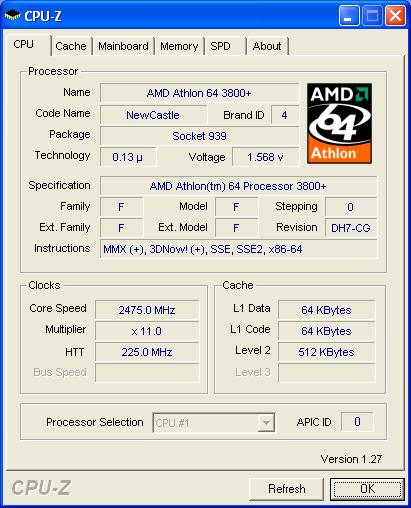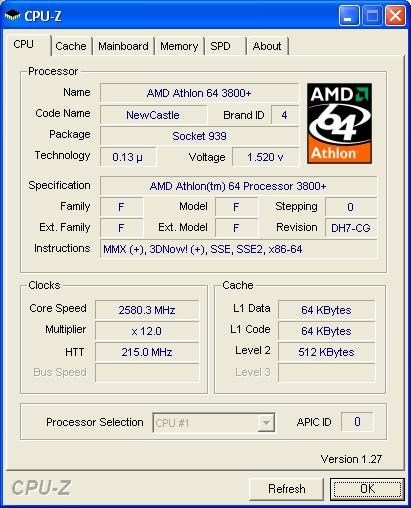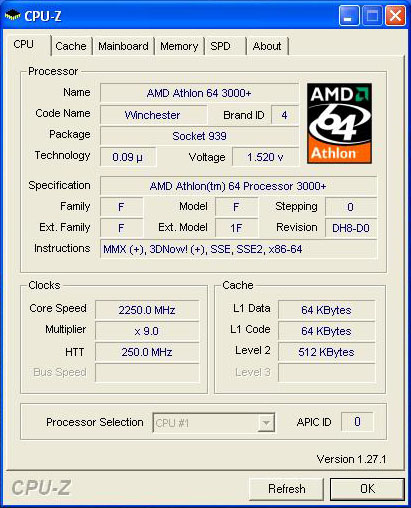Overclocking
With Athlon 64 processors being downward multiplier unlocked, overclocking options are abundant. We have a 3800+ CPU running at 2.4 GHz with a 12X multiplier. In theory, then, a 10X multiplier and a 240MHz bus would give us the same 2.4GHz. That doesn't necessarily translate into dramatically improved performance, but at least it should let us know whether or not the motherboard can properly run with a higher bus speed. Here are the overclocking results that we attained with the current BIOS revision.
Maximum FSB

We were unable to get the system to run properly with a CPU bus higher than 224MHz, regardless of what RAM timings, HyperTransport multiplier, CPU voltage, etc. that we had specified. We ended up using 2-3-2-6 timings, but we are clearly limited by something other than the RAM. That is a rather disappointing result as far as overclocking is concerned. Unless this is improved, those looking at purchasing a 90nm Athlon 64 3200+ and overclocking to 2.5GHz are going to be disappointed. Our guess is that the PCI Express bus is not locked to 100 MHz, so at a bus speed of 224 MHz, the PCIe bus would be at 112MHz. Pushing the speed of the PCIe bus beyond 112MHz would certainly begin to cause issues.
Maximum CPU

Sticking with the maximum 12X multiplier of our CPU, we were able to reach a CPU speed of 2568MHz using a bus speed of 214MHz. Since our 3800+ is a 130nm chip, we are most likely limited by the CPU rather than by the system. (We have not fully tested this particular CPU in other systems, so the maximum overclock is an unknown, but near 2.6GHz is pretty typical for the 130nm Athlon 64 chips.)
Latest BIOS (FN25S906.BIN)

Shuttle sent us results showing the improvements to their latest BIOS revision. They are able to hit a 250 MHz bus without problems, yielding a clock speed of 2250MHz with their 90nm 3000+ chip. They are still working on increasing the supported (and stable) bus speeds to 300 MHz, and we will report results for this once we receive the latest BIOS version.
If you're looking for a really great overclocking SFF, the SN25P appears to be able to deliver. Given the early nature of the product that we're reviewing, future BIOS and motherboard revisions should continue to improve the situation. The initial BIOS that we received didn't allow proper adjustment of memory timings, and later versions were unable to run beyond a 224 MHz CPU bus. Once again, we see that for overclocking support, proper BIOS programming can make or break a system. We still have some reservation about the overclocking worthiness of the SN25P, but assuming that they can get stable support up to 300 MHz, it will be one of the best - perhaps "only" may be the better term - overclocking platforms for socket 939 among SFF systems.













30 Comments
View All Comments
Iargonaut - Wednesday, May 4, 2005 - link
One question - not concerning image quality (there are several other reviews on the net with worse pictures!) - how about the stability and the speed of the ethernet port? I read on sfftech.com that there have been some issues with this.And finally when and what is the next nforce 4 SFF to be expected?
Thanks and as always: great review!
JarredWalton - Saturday, July 30, 2005 - link
Soon... very soon! Including some updated SN25P benchmarks (Network as well as overclocking).JarredWalton - Friday, March 11, 2005 - link
I understand that GIF/PNG would have been smaller. Again, I have deleted the originals, and the Shuttle provided image was already in JPG format. If I were to convert them to GIF/PNG now, the JPEG artifacts make it pointless. The system is disassembled, so I can't just recreate the images at the drop of a hat.As far as bandwidth and page loads are concerned, bandwidth is practically free for servers. It's not a major concern. I mean, I contributed to a reduction in bandwidth by creating thumbnails that are 1/9 the size of the larger images, mostly because I don't think a lot of people are really that concerned about looking at *every* image in high detail.
Personally, I'm more upset about the lousy quality of some of my pictures (not a very good camera) than I am with the size of the CPUZ images. I'm still trying to figure out the best way to get clean images. I'll be trying some brighter lights for the next set of pictures, so we'll see if that helps.
FWIW, even if the entire content of one of our pages was 60KB - which would stream in about 1 second over any broadband connection - it would take anywhere from 2 to 4 seconds to render the pages due to their complexity. Pentium 3 and low end Athlon systems are substantially slower at page rendering. Also, what about the non-AnandTech ad servers? Sometimes those are a bigger bottleneck than anything else. Anyway, I'm not involved AT ALL in the site design, so the only thing I have sway over is what sits in the middle of the pages. :)
cosmotic - Friday, March 11, 2005 - link
You could cut the filesize of the header on each page down by half if you just stuck it in fireworks, clicked gif, then exact palette. You could go a little further by using an 8bit PNG, and also lose pattent issues. If you touched it up a little bit, you could make it 1/4 the originial size.cosmotic - Friday, March 11, 2005 - link
As Ed points out, it saves on bandwidth. If you cut the page sizes in half by optimizing images and such, you would save a ton on bandwidth. Plus, even on broadband, page loads are not instant. If you could get it under 40K, then it would load in 1 second (still not instant). but at 170K, it would take 3 more seconds for people with average broadband connections. When people get fiber in their homes, are you going to start using TIFFs? Not only are you waisting your bandwidth, and the bandwidth of your visiters, your also contributing to clogging up large pipes cross-country. It's not a huge deal, but if every one took your aditude, the internet would be slllooooowwww. Why is it so hard to compress the images? Just stick them in Fireworks or whatever and spend 20 seconds makeing them smaller. If you spend 5 min making all the cross-site images half as small, you would save a bundle on bandwidth.GoatHerderEd - Friday, March 11, 2005 - link
Cosmotic and Jared; As the operator of the site, AT should care because it is using bandwidth. But if they have enough to spare, WTF cares? The users really should not care. Even if they were on dialup, it would still be fast enough. Plus who uses dial up any more? If you read this site, and you use dial up, you’re probably using something to increase page loads that will mutilate the picture anyways. You guys need to give it a rest. Be thankful they aren’t bitmaps! Infact, Jared, you should make them all bitmaps just for fun. See what people say then. We come to AT for the reviews and comments, not for an art gallery.On a separate topic, great article. Keep up the good work; keep those AMD based system reviews coming. I love my XPC. One thing I am mad at is the HDD. I used a Raptor thinking it would be faster. It may be, but not by much. There is one big issue with it though, its louder than F*CK. It sounds like a really old AT style pc because of the HDD. AHH! I think I may get it replaced soon because its so loud. Defeats the purpose of all the quiet fans.
JarredWalton - Thursday, March 10, 2005 - link
Zepper - repairs of which parts? Shuttle gives a 1 year warranty on their SFFs, and they'll even repair items outside of that warranty for a fee. That's not the greatest warranty ever (many motherboards come with a 3 year warranty), but it's not bad either. The only parts that are really likely to fail are the fans, which you can replace relatively easily. The PSU is the only really proprietary part that might need to be replaced, and even then you can purchase a new SilentX from Shuttle for $60 to $80 (guessing on the 350W, as I can't find a price for it yet).In the end, it *is* an expensive unit, but it's a well-designed unit. An ATX case and nF4 motherboard would cost about half as much. Shrinking sizes usually increases costs, and the quality of the parts used in this case looks to be better than what would go into a cheap to moderate ATX case. I wouldn't expect much in the way of repairs/failures if you clean it out with compressed air every 3 months. I know quite a few people that have been running XPCs for two years without trouble.
Zepper - Thursday, March 10, 2005 - link
Cost of long-term ownership too high with all those proprietary parts....bh.
JarredWalton - Thursday, March 10, 2005 - link
21 - I can't believe anyone cares! I mean, who even notices that an image is 50K instead of 15K anymore? Dial-up users... but do we really get many of those? I don't know. I'm not in charge of the site layout, however, which as I've mentioned is about 170K all on its own. You might as well start complaining about all the advertisements (which is what runs sites such as this, if you weren't aware). One page out of 12 was 120K larger than it needed to be... and the world moves on. :)Anyway, once I update the article with new overclocking tests (in the next week or so), I'll be sure to replace the JPG images with GIF versions.
cosmotic - Thursday, March 10, 2005 - link
I cant believe your defending using poor formats and those huge page sizes. You should be trying to make the page sizes as small as possible.